 |
|
|
|
| |
  © News, Technology, Space, Science - Breaking News and interesting stories |
|
|
|
|
|
|
|
|
| |
Strange Mars crater.
Nobody knows exactly how this crater on Mars was formed. Scientists believe maybe an object hit the ground in weird trajectory. For sure this is not a volcanic crater. |
  © News, Technology, Space, Science - Breaking News and interesting stories |
|
|
|
|
|
|
|
|
| |
 BITCOIN STOCK.PRICE BITCOIN STOCK.PRICE
This transmission experiment involved sending the equivalent of 400 DVDs per second over 7,000 kilometers, roughly the distance between Paris and Chicago. This is the highest capacity ever achieved over a transoceanic distance and represents an increase that exceeds that of today’s most advanced commercial undersea cables by a factor of ten. To achieve these record-breaking results the Bell Labs researchers made innovative use of new detection techniques and harnessed a diverse array of technologies in modulation, transmission, and signal processing
High speed optical transmission is a key component of Alcatel-Lucent’s High Leverage Network architecture, key elements of which have already been selected by leading service providers.
To achieve these record-breaking results researchers from the Bell Labs facility in Villarceaux, France used 155 lasers, each operating at a different frequency and carrying 100 Gigabits of data per second, to dramatically enhance the performance of standard Wavelength Division Multiplexing (WDM) technology.
“There is no question that this record breaking transmission is a milestone in achieving the network capacity and speeds and a key step forward in satisfying the ongoing explosion in demand,” said Gee Rittenhouse, head of Bell Labs Research. “This is a prime example of Bell Labs preeminent research and demonstrates the ability of our researchers to solve complex problems,” he explained.
The record-breaking figure was derived by multiplying the number of lasers by their 100 Gigabit per second transmission rate and then multiplying the aggregate 15.5 Terabit per second result by the 7000 kilometer distance achieved. The combination of speed and distance expressed in bit per second.kilometers is a standard measure for high speed optical transmission.
The transmissions were accomplished over a network whose repeaters, devices used to sustain optical signal strength over long distances, were spaced 90 kilometers apart. This spacing distance is 20% greater than that commonly maintained in such networks. The challenge of maintaining transmission over these distances was significantly heightened in these experiments because of the noise -perturbation of signals- that is introduced as transmission speeds increase.
The researchers also increased capacity by interfacing advanced digital signal processors with coherent detection, a new technology that makes it possible to acquire details for a greater number of properties of light than the direct detection method commonly applied in today’s systems. Using this technique the researchers were able to effectively increase capacity by increasing the number of light sources introduced into a single fiber yet still separate the light into its constituent colors when it reached its destination.
Details of the breakthrough were presented in a research paper that was reviewed in an exclusive and highly-competitive post deadline session of ECOC 2009, a prestigious European optical communications conference.
This transmission record is just the latest in a long series of Bell Labs optical networking breakthroughs that have become market-changing solutions and generated substantial growth opportunities for Alcatel-Lucent: the invention of Dense Wave Division Multiplexing (DWDM), introduction of non-zero dispersion fiber, 100 Gigabit Ethernet field trials and Differential Phase-Shift Keying (DPSK) at 40 Gigabits per second, the most widely used in 40 Gigabit per second systems worldwide.
Provided by Alcatel-Lucent |
  © News, Technology, Space, Science - Breaking News and interesting stories |
|
|
|
|
|
|
|
|
| |
 The researchers constructed a bacterium's "genetic software" and transplanted it into a host cell. The researchers constructed a bacterium's "genetic software" and transplanted it into a host cell.
The resulting microbe then looked and behaved like the species "dictated" by the synthetic DNA.
The advance, published in Science, has been hailed as a scientific landmark, but critics say there are dangers posed by synthetic organisms.
The researchers hope eventually to design bacterial cells that will produce medicines and fuels and even absorb greenhouse gases. |
  © News, Technology, Space, Science - Breaking News and interesting stories |
|
|
|
|
|
 |
|
 |
| |
2013 BITCOIN BULL RUN CHART
|
By Doreen Walton
Science reporter, BBC News
|


The Murchison meteorite came down in Australia in 1969
|
Scientists say they have confirmed that a meteorite that crashed into earth 40 years ago contains millions of different organic compounds.
It is thought the Murchison meteorite could be even older than the Sun.
"Having this information means you can tell what was happening during the birth of the Solar System," said lead researcher Dr Philippe Schmitt-Kopplin.
The results of the meteorite study are published in the Proceedings of the National Academy of Sciences.
"We are really excited. When I first studied it and saw the complexity I was so amazed," said Dr Schmitt-Kopplin, who works at the Institute for Ecological Chemistry in Neuherberg, Germany.
"Meteorites are like some kind of fossil. When you try to understand them you are looking back in time," he explained.
The researchers says the identification of many different chemicals shows the primordial Solar System probably had a higher molecular diversity than Earth.
The Murchison meteorite landed in a town of that name in Australia in 1969. It has been examined before by scientists looking for specific compounds but this is the first non-targeted analysis and has confirmed a huge variety of carbon-based chemicals.
A study using high resolution analytical tools including spectroscopy allowed the team to identify 14,000 different compounds including 70 amino acids in a sample of the meteorite.
They extrapolated this on the basis of knowledge of how similar organic molecules are arranged in space and calculated that the meteorite should contain several million different chemicals.
But the analysis technique is still limited, as Dr Schmitt-Kopplin explained: "We have to crush a few milligrams from the core of the meteorite to enable the extractions with solvents and thus we only see the extractable fraction."
"In addition we are only seeing the ions we can generate with the ionisation source of our mass spectrometer. With different types of ionisation sources we could see even more."
Burning question
Scientists believe the Murchison meteorite could have originated before the Sun was formed, 4.65 billion years ago. The researchers say it probably passed through primordial clouds in the early Solar System, picking up organic chemicals.
Dr Schmitt-Kopplin hopes the findings might contribute to the debate over how life on Earth originated.
"I guess many people working in these fields with access to this knowledge will have some further hypothesis and will possibly be having some of their hypotheses confirmed."
"Where did we come from and what happened before? We all have that question inside us."
The team is also analysing other meteorites but say Murchison is probably the most complex they have studied. |
  © News, Technology, Space, Science - Breaking News and interesting stories |
|
 |
|
 |
|
|
|
| |
 10 Failed Doomsday Predictions 10 Failed Doomsday Predictions
By Benjamin Radford, LiveScience's Bad Science Columnist
With the upcoming disaster film "2012" and the current hype about Mayan calendars and doomsday predictions, it seems like a good time to put such notions in context.
Most prophets of doom come from a religious perspective, though the secular crowd has caused its share of scares as well. One thing the doomsday scenarios tend to share in common: They don't come to pass.
Here are 10 that didn't pan out, so far:
The Prophet Hen of Leeds, 1806
History has countless examples of people who have proclaimed that the return of Jesus Christ is imminent, but perhaps there has never been a stranger messenger than a hen in the English town of Leeds in 1806. It seems that a hen began laying eggs on which the phrase "Christ is coming" was written. As news of this miracle spread, many people became convinced that doomsday was at hand — until a curious local actually watched the hen laying one of the prophetic eggs and discovered someone had hatched a hoax.
The Millerites, April 23, 1843
A New England farmer named William Miller, after several years of very careful study of his Bible, concluded that God's chosen time to destroy the world could be divined from a strict literal interpretation of scripture. As he explained to anyone who would listen, the world would end some time between March 21, 1843 and March 21, 1844. He preached and published enough to eventually lead thousands of followers (known as Millerites) who decided that the actual date was April 23, 1843. Many sold or gave away their possessions, assuming they would not be needed; though when April 23 arrived (but Jesus didn't) the group eventually disbanded—some of them forming what is now the Seventh Day Adventists.
Mormon Armageddon, 1891 or earlier
Joseph Smith, founder of the Mormon church, called a meeting of his church leaders in February 1835 to tell them that he had spoken to God recently, and during their conversation he learned that Jesus would return within the next 56 years, after which the End Times would begin promptly.
Halley's Comet, 1910
In 1881, an astronomer discovered through spectral analysis that comet tails include a deadly gas called cyanogen (related, as the name imples, to cyanide). This was of only passing interest until someone realized that Earth would pass through the tail of Halley's comet in 1910. Would everyone on the planet be bathed in deadly toxic gas? That was the speculation reprinted on the front pages of "The New York Times" and other newspapers, resulting in a widespread panic across the United States and abroad. Finally even-headed scientists explained that there was nothing to fear.
Pat Robertson, 1982
In May 1980, televangelist and Christian Coalition founder Pat Robertson startled and alarmed many when — contrary to Matthew 24:36 ("No one knows about that day or hour, not even the angels in heaven...") he informed his "700 Club" TV show audience around the world that he knew when the world would end. "I guarantee you by the end of 1982 there is going to be a judgment on the world," Robertson said.
Heaven's Gate, 1997
When comet Hale-Bopp appeared in 1997, rumors surfaced that an alien spacecraft was following the comet — covered up, of course, by NASA and the astronomical community. Though the claim was refuted by astronomers (and could be refuted by anyone with a good telescope), the rumors were publicized on Art Bell's paranormal radio talk show "Coast to Coast AM." These claims inspired a San Diego UFO cult named Heaven's Gate to conclude that the world would end soon. The world did indeed end for 39 of the cult members, who committed suicide on March 26, 1997.
Nostradamus, August 1999
The heavily obfuscated and metaphorical writings of Michel de Nostrdame have intrigued people for over 400 years. His writings, the accuracy of which relies heavily upon very flexible interpretations, have been translated and re-translated in dozens of different versions. One of the most famous quatrains read, "The year 1999, seventh month / From the sky will come great king of terror." Many Nostradamus
devotees grew concerned that this was the famed prognosticator's vision of Armageddon.
Y2K, Jan. 1, 2000
As the last century drew to a close, many people grew concerned that computers might bring about doomsday. The problem, first noted in the early 1970s, was that many computers would not be able to tell the difference between 2000 and 1900 dates. No one was really sure what that would do, but many suggested catastrophic problems ranging from vast blackouts to nuclear holocaust. Gun sales jumped and survivalists prepared to live in bunkers, but the new millennium began with only a few glitches.
May 5, 2000
In case the Y2K bug didn't do us in, global catastrophe was assured by Richard Noone, author of the 1997 book "5/5/2000 Ice: the Ultimate Disaster." According to Noone, the Antarctic ice mass would be three miles thick by May 5, 2000 — a date in which the planets would be aligned in the heavens, somehow resulting in a global icy death (or at least a lot of book sales). Perhaps global warming kept the ice age at bay.
God's Church Ministry, Fall 2008
According to God's Church minister Ronald Weinland, the end times are upon us-- again. His 2006 book "2008: God's Final Witness" states that hundreds of millions of people will die, and by the end of 2006, "there will be a maximum time of two years remaining before the world will be plunged into the worst time of all human history. By the fall of 2008, the United States will have collapsed as a world power, and no longer exist as an independent nation." As the book notes, "Ronald Weinland places his reputation on the line as the end-time prophet of God." |
  © News, Technology, Space, Science - Breaking News and interesting stories |
|
|
|
|
|
|
|
|
| |
A new mobile phone charger that will work with any handset has been approved by the International Telecommunication Union (ITU), a United Nations body.
Industry body the GSMA says that 51,000 tonnes of redundant chargers are generated each year.
Currently most chargers are product or brand specific, so people tend to change them when they upgrade to a new phone.
However, the new energy-efficient chargers can be kept for much longer.
The GSMA also estimates that they will reduce annual greenhouse gas emissions by 13.6m tonnes.
"This is a significant step in reducing the environmental impact of mobile charging," said Malcolm Johnson, director of ITU's Telecommunication Standardisation Bureau.
"Universal chargers are a common-sense solution that I look forward to seeing in other areas."
The charger has a micro-USB port at the connecting end, using similar technology to digital cameras.
It is not compulsory for manufacturers to adopt the new chargers but the ITU says that some have already signed up to it.
"We are planning to launch the universal charger internationally during the first half of 2010," Aldo Liguori, spokesperson for Sony Ericsson told the BBC.
"We will roll it out with new products as they launch." |
  © News, Technology, Space, Science - Breaking News and interesting stories |
|
|
|
|
|
 |
|
 |
|
 Buildings on Moon Buildings on Moon
The former manager of the Data and Photo Control Department at NASA’s Lunar Receiving Laboratory during the manned Apollo Lunar Program, Ken Johnston, has released quite a number of sensational statements recently in the USA. The specialist said that U.S. astronauts found ancient ruins of artificial origin and a previously unknown technology to control gravitation when then landed on the Moon. Astronauts took pictures of the objects that they found, but NASA ordered Johnston to destroy the images. Johnston did not follow the order. He said that the U.S. government had been keeping this information a secret for 40 years.
Johnston's startling Apollo allegations have recently appeared in a new book, "Dark Mission: the Secret History of NASA," co-authored by former NASA consultant and CBS Science Advisor, Richard C. Hoagland and Mike Bara, an aerospace engineering consultant. According to Kay Ferrari, JPL Director of the SSA Program (in a phone call to Johnston last week), it was Johnston "being quoted [as] criticizing NASA in Hoagland's new book, 'Dark Mission,'" that prompted her to ask for Johnston's resignation from the SSA Program. When Johnston refused, citing First Amendment protections of free speech afforded all NASA employees, even those at JPL, Ferrari apparently decided to remove him arbitrarily from the SSA Program this week without cause.
The low quality pictures included in the book depict ruins of buildings, huge dome-like objects made of glass, stone towers and castled hanging in the air.
“I have nothing to lose. I have quarreled with NASA and I got fired,” Ken Johnston said.
Indeed, NASA believes that allegations of the ancient civilization found on the Moon are not serious. The authors of the controversial book also say that President John F. Kennedy, who launched the lunar race with the Soviet Union, actually intended to share extraterrestrial technologies with Moscow. Making a speech at the United Nations Organizations in September of 1963, Kennedy supposedly offered the USSR to organize a joint mission to the Moon.
Richard Hoagland believes that Washington’s interest in the Moon exploration that suddenly appeared after 30 years of silence is based on the lunar findings that the U.S. government has been keeping a secret for 40 years. Russia, China, Japan and even India have publicly announced their plans to work on the exploration of the Moon. The USA, Hoagland said, wants to be the first at this point.
|
  © News, Technology, Space, Science - Breaking News and interesting stories
|
|
 |
|
 |
|
|
|
| |

The Risk of ePassports and RFID
Let's take a look at a few other things now possible with ePassports:
ePassports aid Data Theft:
The 3 meter barrier has recently been broken for reading RFID data (e.g. your ePassport data)
from a distance 3 meters away. Attacks always get better. They never get worse. The next barrier
is 5, 10 and 20 meters.
An attacker can read the data from your ePassport (while you walk in the street!) and can use
your credentials to authenticate himself or duplicate your passport.
ePassports aid Terrorism:
Thanks to the ePassports is it now possible to build Smart-IED's. A Smart-IED waits until
a specific person passes by before detonating or let's say until there are more than 10
americans in the room. Boom.
Do ePassports make you feel more safe now as the government says they would do?
Breaking in?
The weakness is in the way the system has been rolled out. The terminal accepts
self-signed data.
This attack is different to the grundwalk attack. VonJeek's attack makes it possible to copy,
forge and modify the data so that it is still accepted as a genuine valid passport by the terminal.
Using a Certification Authority (CA) could solve the attack but at the same time
introduces a new set of attack vectors:
1. The CA becomes a single point of failure. It becomes the juicy/high-value target for the attacker.
Single point of failures are not good. Attractive targets are not good.
Any person with access to the CA key can undetectably fake passports. Direct attacks, virus,
misplacing the key by accident (the UK government is good at this!) or bribery are just a few
ways of getting the CA key.
2. The single CA would need to be trusted by all governments. This is not practical as this
means that passports would no longer be a national matter.
3. Multiple CA's would not work either. Any country could use its own CA to create a valid
passport of any other country. Read this sentence again: Country A can create a passport data
set of Country B and sign it with Country A's CA key. The terminal will validate and display the information
as data from Country B.
This option also multiplies the number of 'juicy' targets. It makes it also more likely for a CA key to leak.
Revocation lists for certificates only work when a leak/loss is detected. In most cases it will not
be detected.
Note: The last item received some comments. Some readers suggested that this can be fixed. Yes,
of course, any system can be fixed. Indeed it would be a first good step by the terminal to check
that a passport from country A is also signed with the CA key of country A and not by the CA key of
country B.
The current implementation and plans make it unlikely that this will be implemented securely. In the
end we are trusted those people who gave out ePassports that can be read by anyone and not just
authorized terminals. We are trusting those people who say that good security practice to verify
the validity of a passport is optional and not mandatory.
So what's the solution? We know that humans are good at Border Control. In the end they
protected us well for the last 120 years. We also know that humans are good at pattern
matching and image recognition. Humans also do an excellent job 'assessing' the person
and not just the passport. Take the human part away and passport security falls apart.
|
  © News, Technology, Space, Science - Breaking News and interesting stories |
|
|
|
|
|
 |
|
 |
| |
A disc that can store 500 gigabytes (GB) of data, equivalent to 100 DVDs, has been unveiled by General Electric.
The micro-holographic disc, which is the same size as existing DVD discs, is aimed at the archive industry.
But the company believes it can eventually be used in the consumer market place and home players.
Blu-ray discs, which are used to store high definition movies and games, can currently hold between 25GB and 50GB.
Micro-holographic discs can store more data than DVDs or Blu-ray because they store information on the disc in three dimensions, rather than just pits on the surface of the disc.
The challenge for this area of technology has been to increase the reflectivity of the holograms that are stored on the discs so that players can be used to both read and write to the discs.
Brian Lawrence, who leads GE's Holographic Storage said on the GE Research blog: "Very recently, the team at GE has made dramatic improvements in the materials enabling significant increases in the amount of light that can be reflected by the holograms." |
  © News, Technology, Space, Science - Breaking News and interesting stories |
|
 |
|
 |
|
|
|
|
|

Satellite Shooted down |
|
|
|
|
 |
|
 |
| |
Did you know?...
- Women in ancient Egypt prevented pregnancy with plugs made of crocodile droppings?
- Based on artifacts and cave paintings, Ice Age women were likely to enjoy sex as much as their male mates?
- In 2005, the average first time for US girls occurred at the age of 17?
- Known aphrodisiacs of the food world include chocolate, oysters and spicy foods?
- That females have a weaker sex drive than men is a cultural misconception?
- The most common sexual problem among men is premature ejaculation?
- It is a common misconception that pregnancy can’t occur without male orgasm?
- Whether put to use or not, males produce about 300 million sperm every day?
|
|
 |
|
 |
|
